As someone fascinated by historical fashion, particularly the elegance of the Victorian era, I often find myself drawn to the romantic image of flowing gowns and intricate details. Yet, as a proud daughter of the Southwest, with roots tracing back to pioneer families, I’m equally intrigued by the practicalities of frontier life and how it shaped women’s clothing. This blend of interests has led me to explore the world of Pioneer Attire, specifically how the clothing of women on the Western frontier differed from the more established fashions of Eastern cities during the 19th century.
Pioneer women faced unique challenges when it came to their wardrobes. From the need for practicality and durability to the desire to maintain a sense of decorum and even style, their clothing choices were a fascinating blend of necessity and adaptation. In this post, we’ll delve into the basics of pioneer attire, uncovering the essential garments that formed the foundation of a frontier woman’s wardrobe. Stay tuned as we explore further details in upcoming posts!
Defining the Frontier for Pioneer Attire
For the scope of this discussion on pioneer attire, we’ll focus on the period roughly between 1850 and 1890, and the regions west of Missouri and Arkansas. The clothing we’ll examine is primarily that worn by women homesteaders and those living in developing settlement communities. While acknowledging the diverse groups inhabiting the West, our focus here will be largely on the pioneer attire of white settlers migrating westward from the East.
What I find particularly compelling about pioneer attire is that it moved away from the rigid dictates of status and conspicuous consumption prevalent in Eastern society. Instead, clothing on the frontier became more about practicality and the shared experience of forging a new life. It reflected the common bond among families pursuing their dreams in the vast, unknown territories of the American West.
The Foundation: Underclothes in Pioneer Attire
Interestingly, the foundation of pioneer attire – the undergarments – wasn’t drastically different from what women wore in Eastern cities. The essential undergarment was the chemise, a simple, lightweight cotton slip. Its primary purpose was hygiene, acting as a barrier between the body and outer garments and being laundered frequently. Next came pantalets, typically made of flannel or cotton. These served purposes of modesty and warmth, predating the widespread use of modern underwear.
Contrary to initial assumptions one might have about the ruggedness of pioneer attire, corsets were a common element. Many women venturing West were driven by aspirations for a better future for their families, whether for economic or religious reasons. They were “proper” women who, despite the hardships, largely maintained the social norms of their time, including wearing corsets, which were considered fundamental to respectable dress.
While the demands of physical labor might have led some women to loosen or forgo their corsets during strenuous tasks, the majority of pioneer women included corsets in their pioneer attire and wore them whenever feasible.
Over the corset came petticoats, a personal favorite garment category. Similar to dresses, women likely owned multiple petticoats of varying weights and formality, choosing them based on the occasion and weather. Stockings were considered essential when leaving the house or receiving guests. They were often held up by garters or, somewhat less comfortably, tucked into the pantalets. The latter method indeed sounds like the least appealing aspect of assembling pioneer attire!
Fabrics of the Frontier: Materials in Pioneer Attire
Calico reigned supreme as the fabric of choice for pioneer attire. Often envisioned as quaint floral prints, calico is actually a type of plain-woven cotton fabric, slightly heavier than muslin and lighter than canvas. Its attributes made it ideal for the demands of frontier life: lightweight, durable, and relatively easy to clean. General stores offered calico in a variety of dyed colors. Alternatively, women could dye the fabric themselves using commercially available dyes or natural pigments extracted from local plants like leaves, bark, berries, and fruits.
However, cotton and silk fabrics were still reserved for “Sunday best” and more formal dresses within pioneer attire. Many women brought finer garments made from these materials with them as they moved West.
While fabrics became increasingly accessible through general stores, the frequency of access varied greatly across the frontier. In more remote areas, families often had to rely on homespun fabrics, a fascinating topic deserving of its own dedicated exploration in a future post.
Daily Life Dressing: Everyday Pioneer Attire
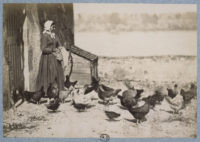 Pioneer woman in daily wear
Pioneer woman in daily wear
Regardless of their backgrounds in the East, women in frontier settlements were integral to the establishment and maintenance of homes and farms. Their days were filled with essential tasks: cooking, cleaning, childcare, laundry, and often, fieldwork. (And yes, perhaps lots of pies, as depicted in popular media!) The success of frontier families depended heavily on the physical contributions of each member, with no room for outsourcing domestic labor. Frontier women quickly adapted to a life of demanding manual work, and their pioneer attire reflected this reality.
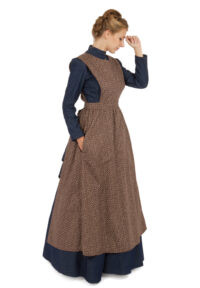 Pioneer Calico Apron
Pioneer Calico Apron
The general dress styles of the Victorian era – fitted bodices and full skirts – were adapted for pioneer attire. Practical modifications were crucial for frontier living. Daily wear dresses had skirts hemmed approximately three inches shorter than fashionable city dresses, allowing for greater ease of movement. Hems might also be weighted to prevent skirts from blowing up in windy conditions, maintaining modesty.
Bodices remained fitted, but sleeves were loosened for comfort and extended to the wrists, often paired with high collars to protect the skin from the sun. These adaptations made pioneer attire more functional for the harsh outdoor environment and demanding daily tasks.
Laundering pioneer attire was a significant undertaking, a task women had to manage regardless of their previous experience with domestic chores. An intriguing garment mentioned in How the West Was Worn is the “wash dress.” This popular two-piece dress, made of white cotton with a printed background, emerged around 1867. Its appeal lay in its easy care, making it readily available in stores and quickly replicated by seamstresses across the West. The “wash dress,” worn by women of various socioeconomic backgrounds, exemplifies how pioneer attire evolved to meet the practical needs of frontier life. While further research on the “wash dress” is needed, its existence highlights the rapid adaptation of fashion to the frontier context.
Sunday Best on the Frontier: Refined Pioneer Attire
 Frontier couple dressed for Sunday
Frontier couple dressed for Sunday
While frontier life often involved isolation, settlements with multiple families invariably established churches. Regular church attendance was generally expected within these communities. Although accounts exist of women in impoverished communities attending church barefoot, it was more common for women to possess at least one or two dresses specifically reserved for Sundays. However, historical records often focus on more privileged settlers, making it challenging to definitively ascertain the most typical Sunday pioneer attire across all communities.
“Sunday best” pioneer attire often mirrored contemporary fashions in Eastern cities. Full skirts, worn over petticoats and corsets, were standard. Sleeve styles, reflecting current trends, included puffed variations like bell, leg-o’-mutton, or pagoda sleeves. Skirt styles also followed fashion trends, with crinolines, hoops, or bustles appearing depending on the decade.
Color choices for Sunday pioneer attire followed conventions: younger women and newlyweds favored lighter colors, transitioning to darker shades as they aged. Dresses were completed with the most fashionable hats available, along with kid gloves and low-heeled boots.
Social Occasions: Dressing Up Pioneer Attire
Beyond daily and Sunday wear, women on the frontier, resources permitting, maintained separate dresses for social events. Dances, holiday celebrations, picnics, and other community gatherings provided opportunities to socialize, and similar to their Eastern counterparts, women dressed for these occasions.
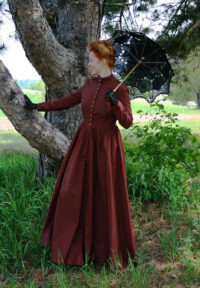 Woman in church dress pioneer attire
Woman in church dress pioneer attire
These social dresses were highly valued. Women might order fabrics from the general store, eagerly anticipating the chance to create fashionable garments. Godey’s Lady’s Book, a popular magazine, was widely circulated and highly influential. Frontier women eagerly shared copies, copying dress patterns and styles featured in its pages to create their own versions of fashionable pioneer attire.
Fabric availability for social dresses depended heavily on the proximity and accessibility of general stores. In many instances, women possessed a limited wardrobe, necessitating versatility. In such cases, their finest dress served for special events, with embellishments added to elevate the ensemble. Hand-crocheted collars, shawls, and other accessories played a crucial role in transforming everyday pioneer attire into something suitable for socializing.
Accessorizing Pioneer Attire: The Finishing Touches
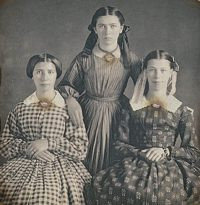 Frontier girls with accessories
Frontier girls with accessories
My research into pioneer attire revealed the surprising significance of accessories in a frontier woman’s wardrobe. Beyond the fundamental garments, accessories were far from afterthoughts; they were essential for adding polish and personal expression to pioneer attire. The emphasis on jewelry and accessories in historical accounts has led me to compile a list and plan a future post dedicated to exploring these details further.
Women on the frontier enhanced their pioneer attire with:
- Aprons
- Boots
- Brooches
- Lockets
- Earrings
- Precious stones and metals
- Hair adornments
- Hats
- Collars and cuffs
- Gloves
- Undersleeves
- Parasols
- Fans
- Handbags
- Shawls
The Enduring Legacy of Pioneer Attire
My growing interest in my own pioneer ancestors has deepened my fascination with this era. While “prairie style,” “pioneer,” and “western wear” clothing are readily available commercially, finding detailed historical information about how women balanced propriety, beauty, and fashion with the practical demands of frontier life proved to be a compelling pursuit.
I look forward to continuing my exploration of pioneer attire and hope you will join me for my upcoming post focusing on accessories in frontier fashion.
Recreate Your Pioneer Look:
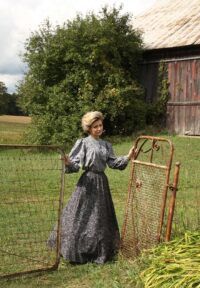 Woman in pioneer clothing
Woman in pioneer clothing
Pioneer Calico Blouse and Skirt
Browse our entire pioneer clothing collection
Pioneer Calico Blouse and Skirt
Harper Victorian Pioneer Dress
Pioneer Blouse, Apron and Skirt


